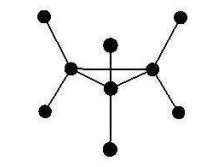6.12: Cyclopropane
- Page ID
- 149475
D3h Symmetry - C3H6
The following IR and Raman spectroscopic data is available for cyclopropane, C3H6. Demonstrate that this data is consistent with a D3h symmetry assignment for cyclopropane.

\[ \begin{pmatrix} \text{Frequency} & 3038 & 1479 & 1188 & 3025 & 1438 & 1029 & 866 & 3103 & 854 & 3082 & 1188 & 734 \\ \text{Activity} & R & R & R & R, IR & R,IR & R, IR & R,IR & IR & IR & R & R & R \\ \text{Type} & \blacksquare & \blacksquare & \blacksquare & \blacksquare & \blacksquare & \blacksquare & \blacksquare & \blacksquare & \blacksquare & \blacksquare & \blacksquare & \blacksquare \\ \text{Symmetry} & \blacksquare & \blacksquare & \blacksquare & \blacksquare & \blacksquare & \blacksquare & \blacksquare & \blacksquare & \blacksquare & \blacksquare & \blacksquare & \blacksquare \end{pmatrix} \nonumber \]
\[ \begin{matrix} ~ & \begin{array} E & C_3 & C_2 & \sigma_h & S_3 & \sigma_v \end{array} \\ E_{D3h} = & \begin{pmatrix} 1 & 1 & 1 & 1 & 1 & 1 \\ 1 & 1 & -1 & 1 & 1 & -1 \\ 2 & -1 & - & 2 & -1 & 0 \\ 1 & 1 & 1 & -1 & -1 & -1 \\ 1 & 1 & -1 & -1 & -1 & 1 \\ 2 & -1 & 0 & -2 & 1 & 0 \end{pmatrix} & \begin{array} A1':~x^2 + y^2,~z^2 \\ A2':~Rz \\ E':~(x,~y),~(x^2-y^2,~xy) \\ A1":~ \\ A2":~z \\ E':~(Rx, Ry),~(xz,~yz) \end{array} & D3h = \begin{pmatrix} 1 \\ 2 \\ 3 \\ 1 \\ 2 \\ 3 \end{pmatrix} & \Gamma_{uma} = \begin{pmatrix} 9 \\ 0 \\ 1 \\ 3 \\ 0 \\ 3 \end{pmatrix} & \Gamma_{bounds} = \begin{pmatrix} 9 \\ 0 \\ 1 \\ 3 \\ 0 \\ 3 \end{pmatrix} \end{matrix} \nonumber \]
\[ \begin{matrix} A_1 = (C_{D3h}^T )^{<1>} & A_2 = (C_{D3h}^T )^{<2>} & E = (C_{D3h}^T )^{<3>} & A_{11} = (C_{D3h}^T )^{<4>} \\ A_{21} = (C_{D3h}^T )^{<5>} & E_1 = (C_{D3h}^T )^{<6>} & h = \sum D3h & \Gamma_{tot} \overrightarrow{ \left[ \Gamma_{uma} (A_{21} + E) \right]} \end{matrix} \nonumber \]
\[ \begin{matrix} \Gamma_{tot}^T = \begin{pmatrix} 27 & 0 & -1 & 3 & 0 & 3 \end{pmatrix} & \Gamma_{vib} = \Gamma_{tot} - A_2 - E - A_{21} - E_1 & i = 1 .. 6 \\ \Gamma_{stretch} = \Gamma_{bonds} & \Gamma_{bend} = \Gamma_{vib} - \Gamma_{stretch} \end{matrix} \nonumber \]
\[ \begin{matrix} \text{Vib}_i = \frac{ \sum \overrightarrow{ \left[ D3h (C_{D3h}^T )^{<i>} \Gamma_{vib} \right]}}{h} & \text{Stretch}_i = \frac{ \sum \overrightarrow{ \left[ D3h (C_{D3h}^T )^{<i>} \Gamma_{bend} \right]}}{h} & \text{Bend}_i = \frac{ \sum \overrightarrow{ \left[ D3h (C_{D3h}^T )^{<i>} \Gamma_{bend} \right]}}{h} \\ \text{Vib} = \begin{pmatrix} 3 \\ 1 \\ 4 \\ 1 \\ 2 \\ 3 \end{pmatrix} \begin{array} A1':~x^2 + y^2,~z^2 \\ A2':~Rz \\ E':~(x,~y),~(x^2-y^2,~xy) \\ A1":~ \\ A2":~z \\ E':~(Rx, Ry),~(xz,~yz) \end{array} & \text{Stretch} = \begin{pmatrix} 2 \\ 0 \\ 2 \\ 0 \\ 1 \\ 1 \end{pmatrix} \begin{array} A1':~x^2 + y^2,~z^2 \\ A2':~Rz \\ E':~(x,~y),~(x^2-y^2,~xy) \\ A1":~ \\ A2":~z \\ E':~(Rx, Ry),~(xz,~yz) \end{array} \\ \text{Bend} = \begin{pmatrix} 1 \\ 1 \\ 2 \\ 1 \\ 1 \\ 2 \end{pmatrix} \begin{array} A1':~x^2 + y^2,~z^2 \\ A2':~Rz \\ E':~(x,~y),~(x^2-y^2,~xy) \\ A1":~ \\ A2":~z \\ E':~(Rx, Ry),~(xz,~yz) \end{array} \end{matrix} \nonumber \]
\[ \begin{pmatrix} \text{Frequency} & 3038 & 1479 & 1188 & 3025 & 1438 & 1029 & 866 & 3103 & 854 & 3082 & 1188 & 734 \\ \text{Activity} & R & R & R & R, IR & R,IR & R, IR & R,IR & IR & IR & R & R & R \\ \text{Type} & S & S & B & S & S & B & B & S & B & S & B & B \\ \text{Symmetry} & A1' & A1' & A1' & E' & E' & E' & E' & A2" & A2" & E" & E" & E" \end{pmatrix} \nonumber \]
There are 9 Raman active modes, 2 IR active modes, 8 IR/Raman active, and 2 modes that are neither Raman or IR active. This gives a total of 21 vibrational modes which is consistent with the total degrees of freedom (27=3x9) minus 6 for translation and rotation.

